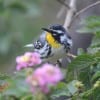 By Jim Stevenson,
By Jim Stevenson,
Hi Folks, Last call for the field trip Saturday on the Island’s West End.
EVERYONE INTERESTED IN THE ARIZONA TRIP PLEASE CONTACT (OR RE-CONTACT) ME. I ACCIDENTALLY DELETED THE LIST! Ooops. We also have room for several more on the Great Plains (Montana) Trip, 19-30 May.
This report is on early migrants, mostly, and we have a ton of them right now on the Island! Jim
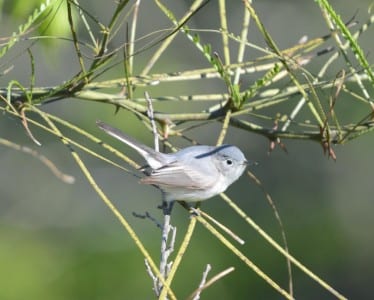
Gnatcatchers got their origins in the Old World but crossed the Alaskan Land Bridge to North America many thousands ofyears ago. This Blue-gray Gnatcatcher is over much of North America, with several rare species along the Mexican Border. These are very early migrants, often timing their movements with the outbreak of sand gnats (no-see-ums). This bird is either a female or a male that’s not achieved breeding plumage yet.
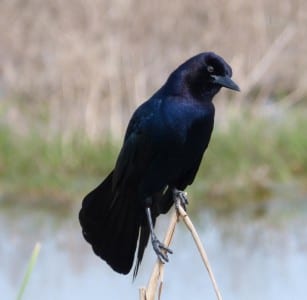
In Texas, this is the “other” grackle. Great-tails are everywhere, Commons are abundant in much of Texas, but these boat-tails are local along the Upper and Central Texas Coast. Here in the Gulf they have dark eyes, as opposed to the light eyes on the Atlantic Coast. Boat-tails opt mostly for freshwater marshes but will inhabit salt marshes in some areas, such as Bryan Beach (but not Galveston!).
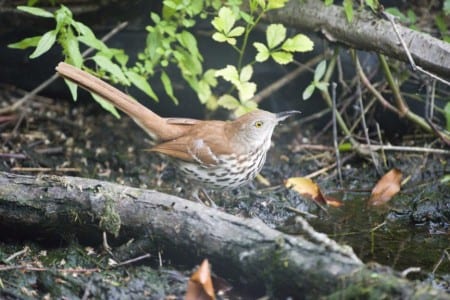
Brown Thrashers are all over the Eastern United States but are only winter residents in from our area down the coast to about where Long-billed Thrashers begin. These are not the mimics mockingbirds are but I’ve heard some issue recognizable songs incognito. Thrashers are largely ground feeders in the southern United States from Florida to California, with a dizzying array of species Out West.
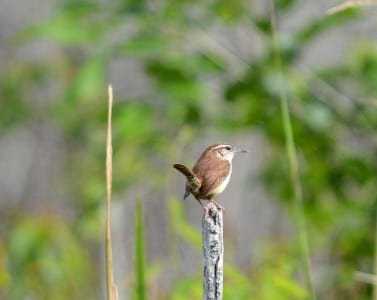
Carolina Wrens are also abundant in the east and the brown they share with thrashers allows them to blend with the woods perfectly. Like many eastern representatives of a group, they are a richer brown than western species, and quite loud to penetratetheir habitat of deep woods. Like many non-migratory birds, they have a deep array of songs not usually encountered in birds that migrate.
As a former music major, I have noticed that their notes somewhat resemble the descending pitches of the black notes on the piano, like (starting with B-flat) whole step, whole step, minor third, whole step, minor third, etc. “]
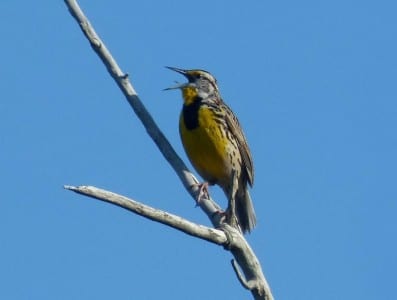
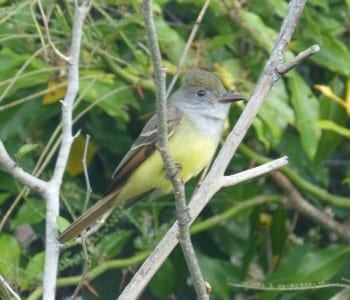
Great Crested Flycatchers slip through in the canopy and spread out all over the hardwoods of North America, virtually to Canada. Their genus encompasses 26 species similar to them, scattered throughout the Western US, Central America and northern South America. Their ascending “weep!” often belies their presence, though sometimes they opt for the low scold.
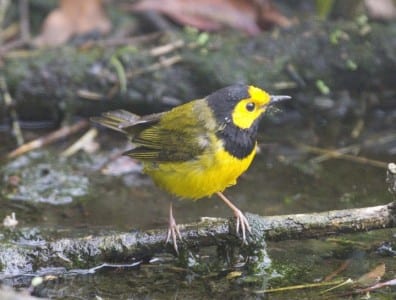
Hooded Warblers are one of many “southern” breeding songbirds that are easily found migrating in March and early April. Like many songbirds that cross the Gulf, it wasn’t long before this individual bathed in my pond to get the salt off. Most of our early birds nest in East Texas but don’t breed in the Galveston area.
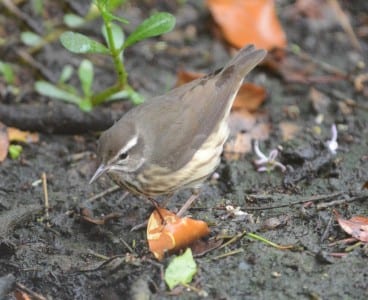
Not often photographed, and far less common than their more northern cousins, the Louisiana Waterthrush sneaks through in March, and back through in late summer. Despite the poor picture you can see the eye stripe is wider behind the eye and the legs are flesh-colored. These breed most commonly on the great southern rivers of the US.
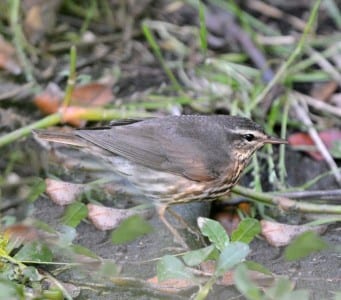
Much more common, and sometimes an early migrant, is the Northern Waterthrush, a bird that breeds all the way to Alaska. Curiously, the early arrivals look a bit more like Louisianas than the later ones and I had to do a double-take to realize this species. It is fortuitous that their chips are different as they are often heard back in the hidden areas where waterthrushes like to forage.
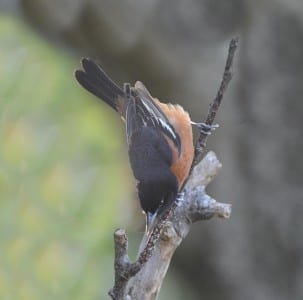
Orchard Orioles are southern breeders and thus are early migrants. Males are not the bright orange of Baltimores, but rather the burnt orange of UT. They often nest in more scrubby areas, unlike their bright cousins who prefer mature trees. The ladies lack any orange and are lemon yellow. Each year they *almost* breed in my yard, but haven’t yet.
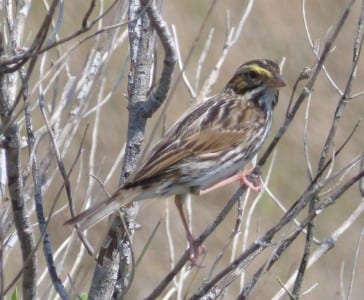
By far, our most obvious sparrow is the Savannah, often seen from roadsides, in fields and pastures. This is a fairly dark individual but they may be lighter or even slightly darker. The plain tail, yellow lores and heavy ventral streaking are helpful in identification. This family has some tough species to separate but always start with whether the undersides are streaked.
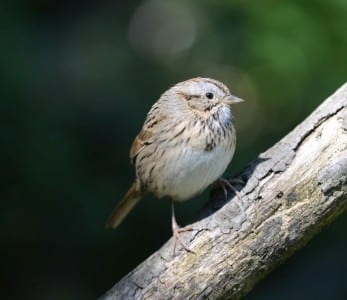
One sparrow with streaks is the Lincoln’s, a bit secretive but fairly common in Texas. The chest has a curious streaked, buffy band unlike anything else in the bird world (to my knowledge). Their head is a bit like a Song Sparrow, but the chest is the kicker. This species prefers dry, thick places while Swamp Sparrows, which are unstreaked, opt for damper locations.
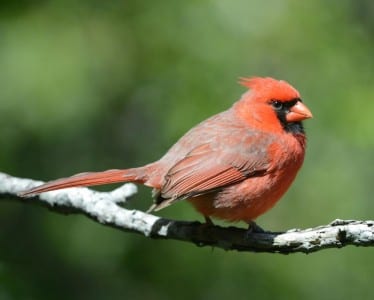
Did I just hear you say, “Oh, “just” a cardinal???” This fine male has lived in my yard since just after Ike and he and his babe are pretty successful raising their young in summer. While there is an unrelated “Red-capped Cardinal,” there is actually a closely-related species in Venezuela called the Vermilion Cardinal, in the hot, dry Littoral Zone. BTW, last summer I left my digital camera outside briefly and this bird came and ate it, card ‘n all.
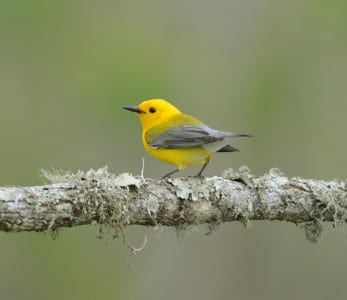
One of those neat, southern nesters, the Prothonotary Warbler prefers swamps like Brazos Bend State Park provides. They are named for the office in the Catholic Church (this is NOT a joke!) who wears the golden robe. There are actually about a half-dozen species named for various parts of that church. Note the size of the bill, used for probing holes for arthropods.
”]
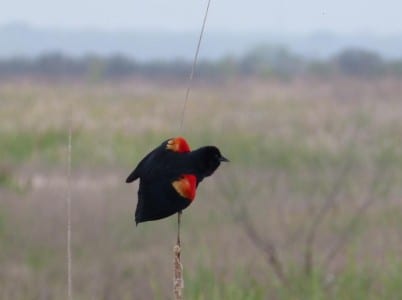 ”]
”]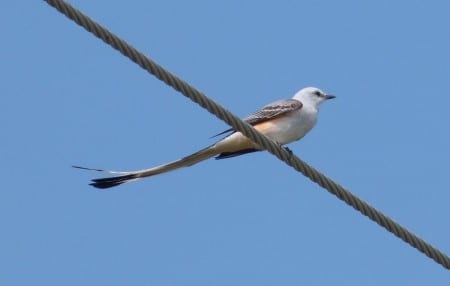
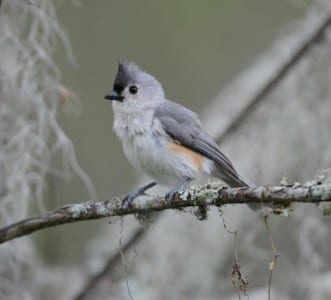
It’s curious how several species of birds are either totally absent or scarce on all or most Islands in the Gulf of Mexico. Titmice, chickadees, Blue Jays, American Crows, Brown-headed Nuthatches and Black Vultures are some of the species that range from quite scarce to completely absent on Gulf Islands like Galveston. This male Tufted Titmouse came into my squeak at Brazos Bend State Park
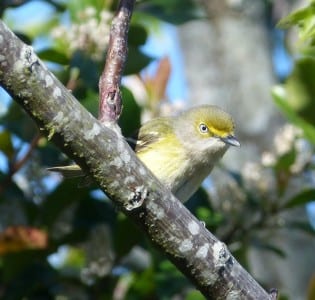
And speaking of… I have never heard of White-eyed Vireos breeding on Gulf Islands, but I have had two of these for over two weeks in my yard. The male isn’t singing (yet?) but if they aren’t going to breed, why are they sticking around? Note the cylindrical bill with a hook for pulling caterpillars out of crevices.
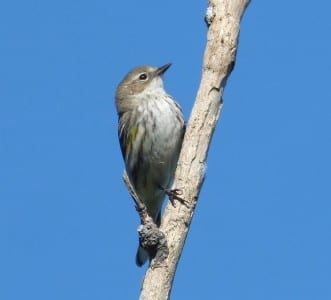
The Yellow-rumped Warbler that has spent the winter with us will still be common until about mid-April, when males will begin showing lots of black and yellow. This bird above is a male before the magical transition to breeding plumage transpires. Note the thicker-than-most-warbler’s bill for eating berries, somewhat different from fellow winter resident Orange-crowned Warbler that punctures berries.
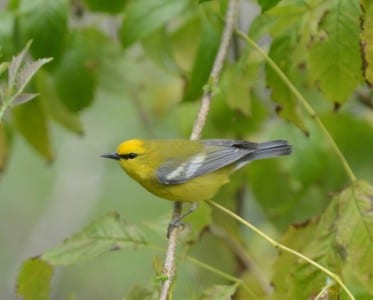
Other more exciting warblers sneak through in early spring, such as this Blue-winged. This species is very closely related to the Golden-winged (my favorite bird), although it migrates on average earlier. These two actually hybridize and produce fertile offspring, which backcross and create all kinds of odd-looking crosses, called “Brewster’s” and “Lawrence’s.” Others even have characteristics of both!
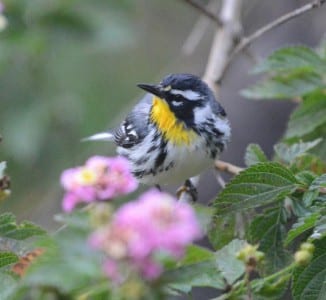
Always an early migrant, the Yellow-throated Warbler could be overlooked for a Black-and-white Warbler until the bird turns his head and the yellow throat zaps your eyes. This wet bird was put down in a rain shower Monday afternoon, along with a few other kinds of songbird migrants. Otherwise, they likely would have passed over and headed inland. Their longish bill is handy for working the bark of trees.
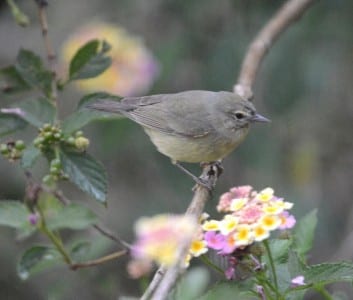
A truly terrible picture, I went ahead with it coz so many folks struggle with the ID of this bird. This is the Orange-crowned Warbler, a winter resident that punctures berries as part of its winter diet. Note the overall dull color, sharp-pointed bill and faint, light mark on the bend of the wing. Many pass this up for a Tennessee, but I have heard them called a plethora of names, including a few I can’t repeat.
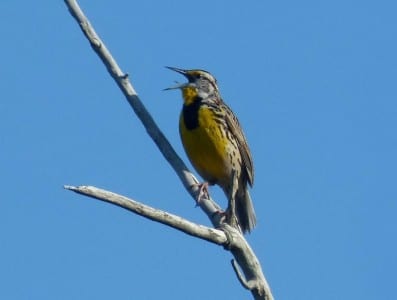
Eastern Meadowlarks are singing their hearts out right now, looking for any structure that elevates them from the grassland below. They are related to blackbirds (look at the bill) but take on the color of the ground. The black bib on yellow is curiously also found in several unrelated birds living in fields around the World, such as a pipit, an oriole and a finch. Check out the Dickcissel in the field guide.
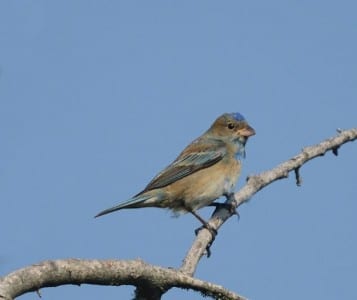
Check out these three Indigo Bunting males taken on Monday. This one only has just a little bit of blue up front, plus atad in the wings and tail.
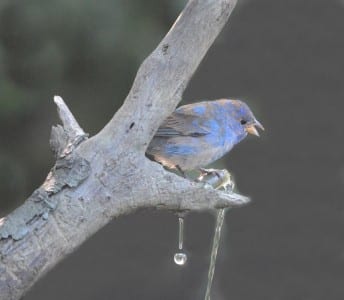
This one, at my drip, has far more blue, and so is further along in plumage change as well as gonadal development. And…
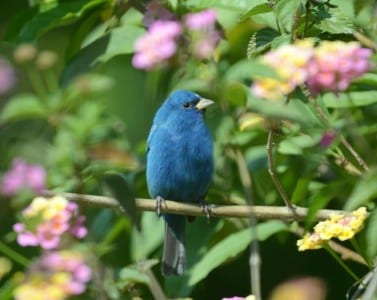
This fine male has already transformed and will be singing on territory when the gals arrive. Like MANY species, they do not breed in the Galveston area but do nest not far away, such as east of Houston. Curiously, the Painted Bunting does breed on the Upper Texas Coast, including my yard!
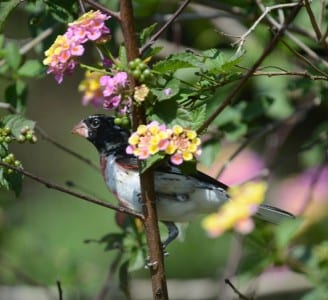
Many birds like the previous buntings migrate while molting, and this curious male Rose-breasted Grosbeak is well underway toward full breeding colors. This is one of America’s tamest songbirds, unlike some (many of which are blue!) that seem inherently scared of humans. Of course, I’m not sure we’ve earned their trust.
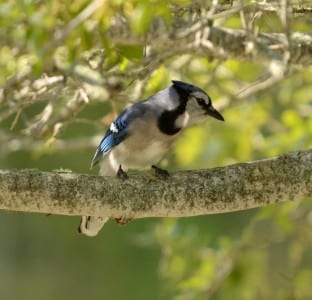
So are Blue Jays migratory or not? Well, there are two races, the Southern Blue Jay and the Northern Blue Jay. In fall, we are invaded by the larger Northerns, who spend the winter in the company of ourpoor little Southerns. But now, in spring, the Northerns go back north and our Southerns quietly build nests and make babies. In Laffite’s Cove, on the Island, thispair of Southerns sneaks around doing the business of reproduction.

 Posted in
Posted in 

























Pleasing tip. I like just how powerful the entire design appearance.
My homepage – Make Your Own Storage